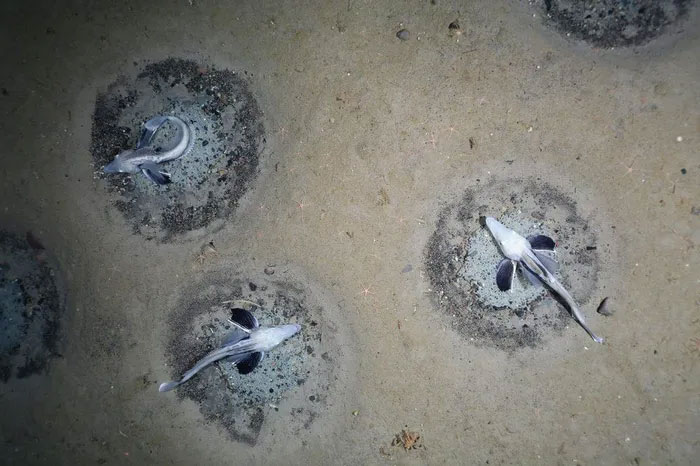In 2019, a group of scientists traveled to Antarctica to produce a scientific documentary and unexpectedly discovered a new species of fish. The scientists shared that their research topic focused on studying marine organisms living in extreme environments. Therefore, they used nets to sweep the seabed and inadvertently found many new species, including this icefish.
The Strange Icefish
This icefish has been identified by scientists as a new species. They have a pale pink color, smooth, slimy skin, and at first glance, they resemble a cross between a tadpole and a snail. This icefish can only survive in cold water environments. They will die if the temperature rises above 5 degrees Celsius due to excessive heat.
It is evident that if humans want to transport this icefish elsewhere, they must ensure that the tank temperature remains below 5 degrees Celsius. The lead researcher, Professor Andrew Stewart, stated: “I have yet to determine what species this is. They are endemic to Antarctica, and I have not seen them anywhere else. The patterns on their fins are different from any species I have encountered before.”
In terms of appearance and coloration, this new icefish species is completely different from the population of icefish, which numbers up to 60 million, discovered in February 2021 in the Weddell Sea in Antarctica. This massive school of icefish was discovered by the German research vessel Polarstern while conducting seabed surveys. The discovery of the school was unexpected, as the initial mission of the research vessel was to survey ocean currents.

Scientists have found a new species of icefish in Antarctica. (Photo: Baidu)
Along a 6-kilometer stretch of the seabed, scientists found countless fish nests. Approximately every 3 square meters contained a fish nest. Each nest had a diameter of 75 cm, a depth of about 15 cm, and contained over 1,000 eggs. On each nest was an adult fish guarding it. This school of fish occupies an area of over 240 km2. According to scientists’ estimates, this school contains around 60 million individuals.
Icefish are known to be a unique species capable of surviving in the coldest marine environments on Earth. Icefish are divided into 33 different genera. Most icefish typically have wide pectoral fins and two dorsal fins supported by long, flexible spines.
A distinctive feature of icefish species is their lack of scales. This adaptation facilitates the absorption of oxygen through seawater. Icefish do not have swim bladders, so they spend most of their lives at the ocean floor. They typically feed on zooplankton, small fish, and mollusks.
The first icefish was discovered in 1927 by zoologist Ditlef Rustad during an expedition to Antarctic waters. The fish that this scientist caught was later named black icefish (Chaenocephalus aceratus).
How Do Icefish Survive in Cold Environments?
Icefish are a species that survived the global freezing event 42 million years ago, which caused the extinction of many species. They diverged from the spiny fish lineage to evolve into icefish. Because icefish live in cold environments, they possess many fascinating characteristics.
Specifically, their bodies have adapted to produce proteins that function similarly to an “antifreeze.” Scientists have analyzed the icefish genome and discovered that the β-globin and α-globin genes have mutated into pseudogenes, which do not participate in hemoglobin synthesis. This mutation has allowed them to survive during the ice ages.

Another icefish population was found in Antarctica. (Photo: Baidu)
Icefish are vertebrates that lack functional hemoglobin genes. The absence of hemoglobin allows icefish to adapt well to the cold conditions of the Antarctic, with temperatures as low as -20°C and high oxygen concentrations. Their blood is not red like that of other animals but is white. This is because their bodies cannot produce red blood cells that carry oxygen in the blood.
Despite lacking hemoglobin, icefish still have sufficient oxygen, thanks to a mechanism that allows direct diffusion into the blood. A large network of small blood vessels under the skin helps the fish absorb enough O2 through diffusion. Icefish continuously live in a state of anemia. They have an oversized heart and very low mineral density in their bones. Although these traits may cause health issues, they are essential for the survival of icefish.
Research from the University of Bochum, Germany, indicates that icefish blood contains a type of glycoprotein antifreeze. This glycoprotein can hydrate water molecules, thereby preventing the freezing of fluids, especially in low-temperature environments.

This new icefish species cannot survive in environments above 5 degrees Celsius. (Photo: Baidu)
Scientists have observed the behavior of glycoprotein antifreeze and water molecules. With the presence of glycoprotein antifreeze, water molecules stabilize and “fluctuate” according to certain rules. Based on the special antifreeze properties of glycoprotein, Antarctic fish can swim freely in low-temperature environments.
According to a study by researcher John Postlethwait from the University of Oregon, the genome of icefish is highly significant for humanity. Because of the evolutionary traits that icefish have developed over time, we may be able to address similar issues in humans, such as osteoporosis, reduced blood cell production, circulatory problems, and obesity.
Imminent Risk of Extinction
Although there are about 100 different species of icefish worldwide, scientists have warned that they are seriously threatened.
According to Professor Thomas Near from Yale University, USA, the primary factor pushing icefish to the brink of extinction is global warming. In recent years, temperatures at both the North and South Poles of the Earth have been rising rapidly. Antarctica is one of the regions most affected by climate change, with rising water temperatures being a notable indicator. When temperatures reach a certain threshold, it becomes difficult to determine whether icefish can continue to survive.

Scientists are seeking ways to combat global warming to prevent the extinction of icefish. (Photo: Baidu)
In particular, Antarctic icefish are highly limited in temperature tolerance; they cannot survive long-term at temperatures higher than those they currently inhabit. As water temperatures in the ocean rise due to global warming, it serves as a reminder that if Antarctic icefish are increasingly exposed to higher temperatures, their existence and development will undoubtedly be jeopardized.
Not only are they facing the threat of climate change, but the survival of icefish is also severely endangered as they are a primary food source for penguins, seals, and toothed whales…
Forecasts regarding the threat to Antarctic icefish have compelled experts to actively seek alternative solutions. However, in reality, there is currently no method that can sustainably conserve them. Even if humanity achieves its emission reduction goals, the risk of some populations disappearing remains. The best measures are to preserve the icefish habitat and promote solutions to mitigate global warming.


















































